In 2010, author Conny den Hollander quit her job as a life insurance specialist and started her working life over again, deciding to do something she really enjoyed. After 25 years in insurance, she made the switch to garden trainee at the Mien Ruys Gardens in the Netherlands. A complete novice at the time, she found her way through asking questions, learning through trial and error, and literally getting her hands dirty.

Mien Ruys, the Dutch landscape architect who championed modernist garden design, is pictured here with a drawing board in 1954.
Fast-forward several years, and Hollander’s hard work paid off. She became head gardener at the Mien Ruys Gardens and had fallen in love with the innovative style of the person whose gardens she was helping preserve: renowned Dutch landscape architect and “mother of the modernist garden,” Mien Ruys.
During her 70 years creating gardens in Dedemsvaart, Netherlands, Ruys focused on incorporating into her designs minimalist, geometric shapes, and clean lines contrasted with simple plantings of perennials and lush vegetation. Through Ruys’s influence, this approach to gardening became the basis of the modernist garden aesthetic of the 20th century and onward.
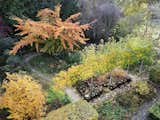
Repeat plantings, lush vegetation, and clean lines are all hallmarks of modernist garden design, as seen here. The Worplesdon sweet gum trees in the center of the garden are pleached, so that the trunks are bare and the tops form a flat canopy—a style known as a “hedge on legs.”
“Mien Ruys was ahead of her time and who—as a woman—managed to become a respected and successful garden designer and landscape architect,” Hollander says. Hollander’s admiration for Mien Ruys as the originator of the modernist garden led her to her book, The Gardens of Mien Ruys: Strong Design, Lush Planting, and the Origins of the Modernist Garden. “I never knew Mien Ruys personally,” she says. “She had died by the time I became really entranced by her gardens.” In order to create a complete portrait of Ruys, Hollander dug through the archives, poring over Ruys’s own books and publications, the video and audio recordings left of her, and the books and articles written about her life and work.
Buy the book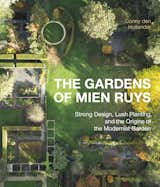 The Gardens of Mien Ruys: Strong Design, Lush Planting, and the Origins of the Modernist Garden
The Gardens of Mien Ruys: Strong Design, Lush Planting, and the Origins of the Modernist Garden
A celebration of 100 years of the Mien Ruys Gardens, where legendary designer Mien Ruys conducted her lifetime of experimentations and innovations that have deeply informed today’s naturalistic gardening movement.
In the book, Hollander sheds light on Ruys as the person, pointing out how she democratized gardening, challenging elitist traditions that saw gardening open only to the upper classes. “Mien Ruys wanted to focus more on green spaces close to social housing and less on assignments for private gardens,” she wrote. Typical modernist gardens lean into geometric shapes and clean lines. Over the course of her career, Ruys gravitated toward plain, streamlined design that seemed appropriate for the building and the surroundings she preferred to garden around.
Democratizing gardening is arguably something Hollander seeks to do as well. “Working and living in a green environment, with your hands in the soil is—for me at least—therapeutic,” she says. And this should be open to everyone. To that end, we’ve tapped garden experts versed in modernist garden design to share how they cultivate the look in green spaces.
What defines a modernist garden? 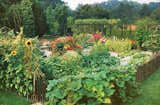
The kitchen garden at the Mien Ruyns garden, shown here in 1981, was maintained by Piers van der Stadt, another Dutch landscape architect who worked alongside Ruyns for years.
Modernist gardens place importance on simplicity, functionality, and a deeper connection between people and their environments. Ruys routinely used industrial materials like concrete and railroad ties juxtaposed against perennial flowers in her designs for many Dutch urban gardens. “What defines a modernist style garden,” Andrew Fisher Tomlin, director at the London College of Garden Design and author of The Modern Professional Planting Designer, says “is strong geometry that connects directly with the architecture of the home and a simplicity of planting, whether that’s a single species of tree or blanket ground cover.”
It’s a garden style characteristically seen in the midcentury-modern home. American practitioners like Dan Kiley, a landscape architect working in the 1940s and ’50s, helped define the midcentury-modern garden style, building off the bold, simple geometries of the architecture of the time, says Jordan Clough, principal at Richardson & Associates Landscape Architecture in Washington, D.C. “Midcentury-modern gardens often employ a simplified materials palette, but with very thoughtful detailing of the joints, connections, and points of transition between materials,” he says.
Plant choice in the modernist garden is also simplified. Modernist gardens typically use large swaths of single species in the planting design to create gardens that mimic the geometry and materials of the architecture.
Creating a dialogue between artificial and natural elements

The Roof Garden at Miens Ruys Garden, as seen here in a photograph from the 1980s, makes abundant use of soft plantings surrounded by hardscaping and incorporates raised beds.
Some elements of modernist gardens endure today, seen in design choices that seek to bridge the gap between man-made environments and the natural landscape. “Concrete as an ornamental material is a great example of a material that was first used in an artistic way,” says Clough.
Think about replicating some of the artificial patterns and motifs found in your home by putting their materials outside in the garden. “Start by studying your house,” says Clough. “What patterns are repeated?” Now pull those forms and materials out into the landscape and consider the “outdoor rooms” as an extension of your home’s architecture.
Embrace bold garden features 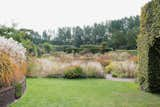
Some examples of “Dutch Wave” planting in Piet Oudolf’s garden in Hummelo (2018) and in the Vlinderhof (butterfly garden) in Máximapark in Utrecht.
According to Nate Fox, lead designer at luxury pool and landscape design company Foxterra Design, if your space is limited, incorporate standout, eye-catching features like vertical green walls, well-placed potted plants, or a trickling water-wall feature. Particularly in urban gardens, try to emphasize any of the space’s man-made materials and their details for your standout feature. After all, modernist garden design genuinely suits industrialized spaces, balancing softness and warmth against otherwise sleek and bare cityscapes.
“It is sometimes overlooked that modernism was originally about elevating very basic materials by how they were used and how they were finished,” says Clough. For example, you can highlight rough stone by placing smooth metal in the form of a sculpture or other geometric forms near it or letting still water from a pond or water feature contrast with the sharp architectural lines of nearby buildings.
Lean into shapes
Instead of wavy or rambling garden paths reminiscent of country gardens, landscape designer Jonathan Fargion of New York City-based Jonathan Fargion Design creates garden walkways that resemble geometric, rectilinear, circular, or even semicircular shapes. “Geometric forms provide a much cleaner aesthetic,” he says.
For Fox, modernist gardens look their best with clean lines and unexpected materials. Think geometrically shaped Cor-Ten steel planters that naturally patina over years, poured concrete benches with knife-edge profiles, or large-format porcelain pavers in monochromatic tones. “These elements provide year-round structure while letting carefully chosen plants take center stage,” he says.
Repeat plantings
The approach to planting is all about intentional restraint and repetition. “Mass plantings of single species—like a sweep of ornamental grasses or a grove of multistem birches—create rhythm and impact without visual clutter,” says Fox. Plants that feel geometric in shape themselves, like agaves, bamboo, or clipped boxwood spheres, are also great choices, as they read as living sculpture.

The repetition as seen here, on either side of the hardscaped path, packs a visual punch, without being too complicated.
The repetitive use of one or two specific plant types, for example, creates a highly impactful visual experience compared to a mix of many different plants. Here too, you can choose distinctly geometric layouts of gardens, says Tomlin.
For Hollander, modernist gardens will always retain a special significance, Ruys’s surviving gardens especially. “The Gardens hold an extraordinary beauty for me. Mien Ruys’s style—the contrast between a clear-cut design and the looseness and lushness of the plants—creates a sense of peace and connection with nature,” she says.
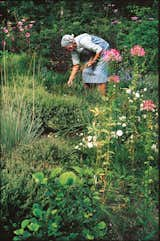
Mien Ruys at work in the heather, 1980.


Comments are closed.